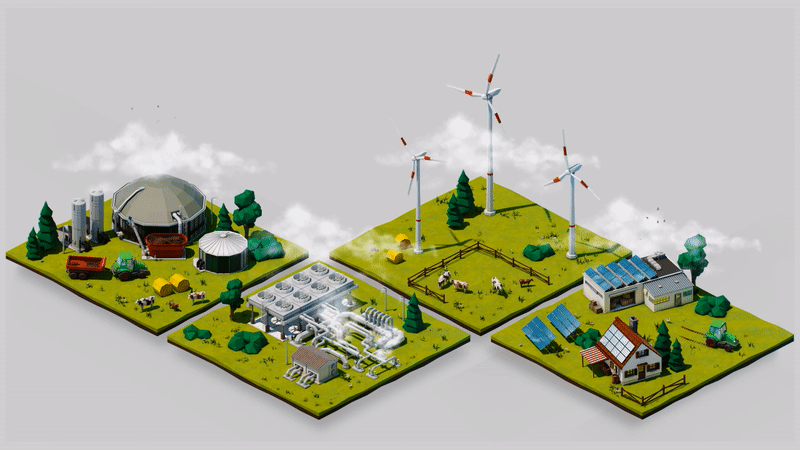Power-to-gas Market size accounted for USD 38.93 million in 2023 and is projected to hit around USD 110.25 million by 2033, growing at a CAGR of 11.24% during the forecast period from 2024 to 2033.
Power-to-Gas (PtG) Market: A Comprehensive Exploration
The Power-to-Gas (PtG) market is rapidly emerging as a cornerstone technology for integrating renewable energy sources into the energy grid and addressing the challenge of energy storage. This deep dive explores the core functions, driving forces, applications, challenges, key players, and future prospects of this dynamic market.
Concept and Functioning:
At its core, PtG bridges the gap between the fluctuating nature of renewable energy generation and the need for reliable energy access. It achieves this by transforming surplus electricity from renewable sources like solar and wind into gaseous energy carriers, primarily hydrogen (H₂) or methane (CH₄). This process enables the storage of renewable energy for later use in various applications, fostering a more flexible and sustainable energy system.
The PtG process generally involves two key stages:
-
Electrolysis: This stage forms the heart of PtG technology. Electricity, ideally from renewable sources, powers the electrolysis process. Here, water molecules (H₂O) are split into hydrogen (H₂) and oxygen (O₂) through a process involving an electrolyzer. The efficiency and cost-effectiveness of electrolysis are crucial for the overall viability of PtG.
-
Methanation (Optional): The produced hydrogen can be directly utilized in fuel cells for power generation or transportation applications. Alternatively, PtG can be coupled with a methanation process. This chemical reaction converts the hydrogen into methane (CH₄), also known as synthetic natural gas (SNG). SNG can then be injected directly into the existing natural gas infrastructure for various applications like power generation, heating, and industrial processes.
Market Drivers:
Several compelling factors are driving the growth of the PtG market:
-
Integration of Renewables: Renewable energy sources like solar and wind offer clean energy generation but are inherently variable. PtG provides a solution by storing excess renewable energy during peak production periods and releasing it back to the grid when needed, ensuring grid stability.
-
Energy Storage Challenge: Grid-scale energy storage solutions are essential for a renewable-powered future. While batteries offer short-term storage, PtG provides a long-term storage option, enabling the utilization of renewable energy even when generation is low.
-
Decarbonization Goals: PtG contributes significantly to decarbonization efforts. By producing clean hydrogen or SNG, PtG displaces fossil fuels in various sectors, reducing greenhouse gas emissions and mitigating climate change.
-
Government Support: Recognizing the potential of PtG, many governments are offering incentives and funding for PtG projects. This financial support is accelerating market development and technology innovation.
Market Applications:
PtG offers a versatile solution with applications across various sectors:
-
Power Generation: Stored hydrogen or SNG can be used in power plants to generate electricity when renewable energy sources are unavailable, ensuring a reliable power supply.
-
Transportation: Hydrogen serves as a clean and sustainable fuel for electric vehicles equipped with fuel cells. PtG can contribute to decarbonizing the transportation sector by providing a renewable source of hydrogen fuel.
-
Industrial Processes: Clean hydrogen can replace fossil fuels in numerous industrial processes, such as steel production and ammonia synthesis. This fosters decarbonization within the industrial sector.
-
Residential Heating: SNG can be injected into the existing natural gas grid, enabling the use of existing infrastructure for clean heating applications in homes and buildings.
Market Challenges:
Despite its potential, the PtG market faces some key challenges that need to be addressed:
-
High Costs: PtG technology is still under development, and the cost of electrolysis and methanation processes remains high. Technological advancements and economies of scale are crucial for driving down costs and making PtG more commercially viable.
-
Renewable Energy Reliance: The environmental benefits of PtG depend heavily on the source of electricity used for electrolysis. Integrating PtG with a robust renewable energy infrastructure is essential for ensuring a sustainable PtG value chain.
-
Infrastructure Needs: Large-scale hydrogen storage and transportation infrastructure is required to fully utilize PtG technology, particularly for SNG applications. Building this infrastructure requires significant investment and long-term planning.
Receive the FREE Sample Report of Power-to-gas Market Market Research Insights @ https://stringentdatalytics.com/sample-request/power-to-gas-market/13353/
Market Segmentations:
Global Power-to-gas Market: By Company
• Hydrogenics
• ITM Power
• McPhy Energy
• Siemens AG
• MAN Energy Solutions
• Nel Hydrogen
• ThyssenKrupp
• Electrochaea
• Exytron
• GreenHydrogen
• Hitachi Zosen Inova Etogas
• Fuelcell Energy
• Avacon
• Carbotech
• Aquahydrex
Global Power-to-gas Market: By Technology
• Electrolysis
• Methanation
Global Power-to-gas Market: Capacity
• Less than 100 kW
• 100–999 kW
• 1000 kW and Above
Global Power-to-gas Market: By Technology
• Wind
• Solar
• Biomass
Global Power-to-gas Market: By Application
• Residential
• Commercial
• Utility
Regional Analysis of Global Power-to-gas Market Market
All the regional segmentation has been studied based on recent and future trends, and the market is forecasted throughout the prediction period. The countries covered in the regional analysis of the Global Power-to-gas Market market report are U.S., Canada, and Mexico in North America, Germany, France, U.K., Russia, Italy, Spain, Turkey, Netherlands, Switzerland, Belgium, and Rest of Europe in Europe, Singapore, Malaysia, Australia, Thailand, Indonesia, Philippines, China, Japan, India, South Korea, Rest of Asia-Pacific (APAC) in the Asia-Pacific (APAC), Saudi Arabia, U.A.E, South Africa, Egypt, Israel, Rest of Middle East and Africa (MEA) as a part of Middle East and Africa (MEA), and Argentina, Brazil, and Rest of South America as part of South America.
Click to Purchase Power-to-gas Market Market Research Report @ https://stringentdatalytics.com/purchase/power-to-gas-market/13353/?license=single
Power-to-Gas (PtG) Market: Historical Developments
The PtG market is a relatively young but rapidly evolving sector. While the core concept of converting electricity to gas has existed for decades, advancements in technology and growing concerns about climate change have significantly accelerated PtG development in recent years. Here’s a look at some key milestones in the PtG market’s history:
Early Developments (Pre-2000s):
- 1920s: The concept of converting electricity to hydrogen through electrolysis (a key step in PtG) was well established.
- 1970s: The oil crisis sparked renewed interest in alternative energy sources, including hydrogen production from renewable electricity.
- 1980s: Research and development efforts focused on improving electrolysis efficiency and exploring methanation technologies for PtG applications.
The Rise of PtG Demonstrations (2000s):
- Early 2000s: Several pilot PtG projects were launched in Europe, demonstrating the technical feasibility of the technology.
- 2008: The first commercial PtG plant in Germany, called “WindGas Falkenhagen,” began operation, injecting hydrogen into the natural gas grid.
- 2013: The “STORE&GO” project in Denmark showcased large-scale PtG integration with a combined heat and power (CHP) plant.
Market Growth and Policy Support (2010s – Present):
- 2010s: Growing concerns about climate change and increasing renewable energy deployment led to increased interest in PtG as a storage solution.
- 2015: The Paris Agreement further emphasized the need for clean energy solutions, providing a significant boost for PtG development.
- Late 2010s – Present: Several governments worldwide implemented policies and incentives to support PtG projects, including feed-in tariffs and funding for research and development.
- Today: The PtG market is still in its early stages of commercialization, but it’s experiencing rapid growth. Technology advancements, cost reductions, and ongoing policy support are expected to drive wider adoption in the coming years.
Additional Points of Interest:
- The historical development of PtG has been closely linked to advancements in related technologies like electrolysis and methanation.
- Early research efforts often focused on hydrogen production for fuel cell vehicles, but the use of SNG (synthetic natural gas) for grid injection has gained traction in recent years.
- Pilot projects and demonstrations have played a crucial role in proving the viability of PtG technology and paving the way for commercial deployment.
About Stringent Datalytics
Stringent Datalytics offers both custom and syndicated market research reports. Custom market research reports are tailored to a specific client’s needs and requirements. These reports provide unique insights into a particular industry or market segment and can help businesses make informed decisions about their strategies and operations.
Syndicated market research reports, on the other hand, are pre-existing reports that are available for purchase by multiple clients. These reports are often produced on a regular basis, such as annually or quarterly, and cover a broad range of industries and market segments. Syndicated reports provide clients with insights into industry trends, market sizes, and competitive landscapes. By offering both custom and syndicated reports, Stringent Datalytics can provide clients with a range of market research solutions that can be customized to their specific needs.
Reach US
Stringent Datalytics
+1 346 666 6655
Social Channels:
Linkedin | Facebook | Twitter | YouTube




Leave a Reply